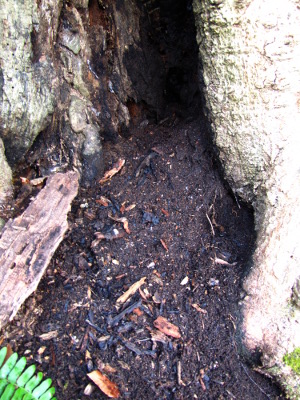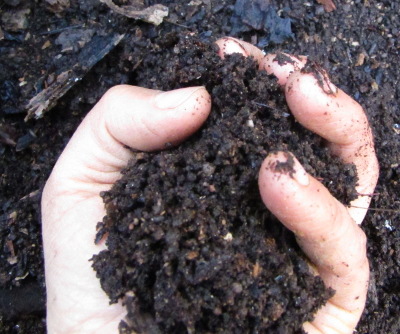
Stump dirt and mushroom compost
 I
consider stump
dirt to be a miracle
planting aid. But what is it?
I
consider stump
dirt to be a miracle
planting aid. But what is it?

The obvious answer is
--- that moist, dark, earthy-smelling organic matter found inside
decaying trees or logs. Different trees create stump dirt of
varying quality; my favorite source by far is our ancient hollow beech
halfway up
the hillside, while box-elders product lower grade stump dirt.
Maybe hardwood stump dirt is better than softwood?
The analytical side of
me started nibbling away at what stump dirt actually is a few weeks
ago, and the best idea I've come up with is that stump dirt is pure
organic matter created when fungi decompose wood. The closest
mainstream garden ingredient I could find is mushroom compost, but that
is the result of fungi growing on higher nitrogen substrates like straw
and manure, so any comparisons should be taken with a grain of
salt. One study of mainstream mushroom compost showed that it
consisted of:
- 28% organic matter and 58% moisture
- 1.12% nitrogen, 0.67% phosphate, and 1.24% potatssium (aka NPK of
1.12-0.67-1.24)
- 2.29% calcium, 0.35% magnesium, and 1.07% iron
- C:N ratio of 13:1
 Naysayers on the internet
report much lower NPK values for mushroom compost, though --- closer to
0.7-0.3-0.3 --- and I suspect our stump dirt is at the lower end of the
fertilizing spectrum. That would explain why the garden beds I
treated with stump dirt last year didn't show much growth --- stump
dirt isn't a replacement for compost. Instead, it makes a great
ready-made potting soil and can also be used like peat moss to fluff up
organic-matter-poor soil. If we ever had enough to apply stump
dirt to our garden in large quantities, I suspect it would act a bit
like biochar, providing spots for
microorganisms to grow unhindered. And stump dirt from
deep-rooted forest trees is probably even higher in micronutrients than the analysis above
portrays.
Naysayers on the internet
report much lower NPK values for mushroom compost, though --- closer to
0.7-0.3-0.3 --- and I suspect our stump dirt is at the lower end of the
fertilizing spectrum. That would explain why the garden beds I
treated with stump dirt last year didn't show much growth --- stump
dirt isn't a replacement for compost. Instead, it makes a great
ready-made potting soil and can also be used like peat moss to fluff up
organic-matter-poor soil. If we ever had enough to apply stump
dirt to our garden in large quantities, I suspect it would act a bit
like biochar, providing spots for
microorganisms to grow unhindered. And stump dirt from
deep-rooted forest trees is probably even higher in micronutrients than the analysis above
portrays.
All of that said, you
can't buy stump dirt, and you only find it in middle-aged to old
forests. I mine a couple of five gallon buckets every year out of
our beech tree, but save it for extra-special occasions. Another
reason to have a mature woodlot on your property, perhaps?
Want more in-depth information? Browse through our books.
Or explore more posts by date or by subject.
About us: Anna Hess and Mark Hamilton spent over a decade living self-sufficiently in the mountains of Virginia before moving north to start over from scratch in the foothills of Ohio. They've experimented with permaculture, no-till gardening, trailersteading, home-based microbusinesses and much more, writing about their adventures in both blogs and books.
Want to be notified when new comments are posted on this page? Click on the RSS button after you add a comment to subscribe to the comment feed, or simply check the box beside "email replies to me" while writing your comment.
